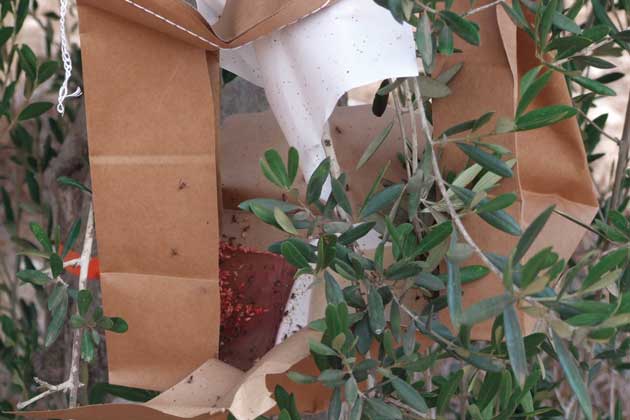Skip to main content
Olive Fly: Nuclear Technology to Protect an Ancient Fruit
<p>It is estimated that the cultivation of olives dates back over 7 000 years.</p><p>Homer wrote about them in his Odyssey, Hippocrates praised olive oil for its medicinal purposes and olive tree leaves were found in the tomb of Tutankhamen.</p>© David Nestel; Chronis Rempoulakis/ARO, Israel
<p>But despite being revered by kings and symbolizing peace, this ancient tree is being attacked by the olive fruit fly.</p><p>The fly poses a serious threat to the olive and olive oil industries in countries in southern Europe, North Africa, the Middle East and the USA where the fruit is grown.</p>© FAO/IAEA
<p>This small, innocuous-looking pest, which only lays its eggs in olives, can infest up to 90% of a farmer's fruit - damaging the crops and the livelihoods of the olive growers and exporters.</p>© David Nestel; Chronis Rempoulakis/ARO, Israel
<p>The female insect lays its eggs in the olives. When the larvae develop they eat away at the fruit, damaging the olive.</p><p>The fly lays only one egg per olive, but a female can lay up to 15 eggs a day, so swarms of thousands of flies can cause considerable damage in one orchard. </p>© Aristides Economopoulos/University of Crete
<p>Scientists from the Joint Division of the IAEA and the UN's Food and Agriculture Organisation are working on a project to control the fly using the proven and environmentally-friendly Sterile Insect Technique (SIT), which uses radiation to sterilise pests.</p>© D. Calma / IAEA
<p>The Sterile Insect Technique (SIT) has worked in the past with other fruit flies and it is now being put to the test to combat the olive fly in southern Israel.</p><p>The IAEA's Laboratories at Seibersdorf, south of Vienna in Austria have been supporting the Israeli olive fly project for several years. Scientists there have bred wild Israeli flies with female flies, and their offspring, in the form of sterilized pupae, were sent to Israel for early experiments in olive orchards.</p>© David Nestel; Chronis Rempoulakis/ARO, Israel
<p>The current pilot project, which is coordinated by the Agricultural Research Organisation, a branch of the Israeli Ministry of Agriculture, is being conducted in an isolated 10-hectare, olive-growing plot in the Lahav Forest in the Negev region of Israel.</p><p>The project is sponsored by the IAEA's Technical Cooperation programme.</p>© David Nestel; Chronis Rempoulakis/ARO, Israel
<p>The sterile flies for mass release are being produced by the Israeli company Bio-fly that was established in 2005 with the support of the IAEA following a successful Sterile Insect Technique (SIT) project to eradicate the Mediterranean fruit fly in an Israeli-Jordanian valley. </p>© David Nestel; Chronis Rempoulakis/ARO, Israel
<p>The Israeli scientists are currently releasing around 40 000 sterile flies a week and the project will run until December 2010.</p><p>Although the project only started in September 2009, the scientists say that field data shows the released fly is very robust and is showing good dispersal capabilities.</p>© David Nestel; Chronis Rempoulakis/ARO, Israel
<p>The team of entomologists in Israel are monitoring the progress of the project by comparing the population trends of the olive flies in the areas where the sterile flies are being released with trends in the reference areas with just wild fly populations.</p><p>They also check and compare the percentage of olive damage and infestation in both the release and reference areas.</p>© David Nestel; Chronis Rempoulakis/ARO, Israel
<p>If the Sterile Insect Technique (SIT) is working, the population of wild pests should be suppressed, since the females, after mating with the mass-released sterile males, will produce infertile eggs.</p><p>The success of a project can be assessed by trapping flies in the release areas to see if the sterile flies are outnumbering their wild counterparts. In order to spot the difference between the wild males and the lab-reared flies the sterile pupae are dipped in a dye.</p>© David Nestel; Chronis Rempoulakis/ARO, Israel
<p>At the IAEA laboratories the entomologists are developing Sterile Insect Technique (SIT) technologies to control the olive fly.</p><p>These technologies would be integrated with other control tactics in olive-producing countries. The scientists breed the flies for their experiments and collect the eggs, which are placed on special trays. The larvae hatch from the eggs, eat away an artificial diet for around a week and then pupate.</p>© FAO/IAEA
<p>Olive flies for release projects and laboratory experiments are irradiated and sterilized in the pupal stage.</p><p>The aim of Sterile Insect Technique (SIT), also known as "birth control for insects", is to suppress populations by breeding large numbers of sterile males. These are released into the wild where they breed with females who in turn produce unfertilized eggs.</p>© FAO/IAEA
<p>To help with the research in Austria, partner countries supply the IAEA team with colonies of wild flies and the mating skills of the sterile males are observed in tents containing olive trees.</p>© FAO/IAEA
<p>Released sterile olive flies must compete with native flies for an effective Sterile Insect Technique (SIT) programme.</p><p>Sterile and wild flies are marked with dots of different coloured paint. So if the scientists see a sterile male mating with a wild female, this is a "good result".</p>© FAO/IAEA
<p>Currently olive farmers have to control the flies using pesticides.</p><p>But there are strict regulations on the amount of pesticide that can be used in olive groves and this is a major concern for olive oil producers. Imported olives are controlled by the receiving countries, and if a certain percentage of infested fruit gets through, the whole shipments of olives can be sent home or destroyed - at the cost of the exporter.</p>© David Nestel; Chronis Rempoulakis/ARO, Israel































